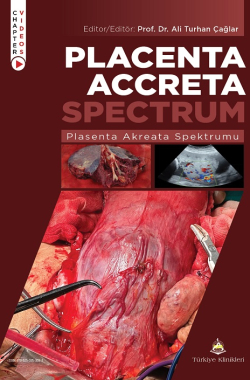Background Of Placenta Accreta Spectrum
Dr. Fahri Burçin Fıratlıgil1
Assoc. Prof. Dr. Zehra Vural Yılmaz2
1Department of Perinatology, Ankara Etlik City Hospital, Ankara, Türkiye
2Department of Perinatology, Ankara Etlik City Hospital, Ankara, Türkiye
ABSTRACT
In 1937, Irving and Hertig first defined the term placenta accreta spectrum (PAS), which they stated as the invasion of trophoblasts into the muscular layer of the uterus and the absence of decidua in the histological evaluation of the placenta after birth. The most well-known risk factor that may cause the development of PAS is a history of previous cesarean section, and this risk increases as the number of cesarean sections increases. Today, as cesarean births are increasing, the incidence of PAS is also increasing worldwide. PAS is directly associated with increased maternal morbidity and mortality as it can cause severe and life-threatening bleed- ing. Therefore, early diagnosis and evaluation of PAS and directing these patients to appropriate centers for delivery before labor begins is critical.
Keywords: Placenta accreta spectrum; Diagnosis; Prevalence; Risk factors; Nitabuch
Kaynak Göster
Referanslar
- Irving C, Hertig AT. A study of placenta accreta. Surgery, Gynecol Obstet 1937; 64: 178-200. [Link]
- Shepherd AM, Mahdy H. Placenta Accreta. In: StatPearls. StatPearls Publishing; 2024. Accessed August 18, 2024. [Link]
- Hecht JL, Baergen R, Ernst LM, Katzman PJ, Jacques SM, Jauniaux E, et al. Classification and reporting guidelines for the pathology diagnosis of placenta accreta spectrum (PAS) disorders: recommendations from an expert panel. Mod Pathol. 2020 Dec;33(12):2382-2396 . [Crossref] [PubMed]
- Jauniaux E, Hussein AM, Einerson BD, Silver RM. Debunking 20th century myths and legends about the diagnosis of placenta accreta spectrum. Ultrasound Obstet Gynecol. 2022;59(4):417-423 . [Crossref] [PubMed]
- Silver RM, Landon MB, Rouse DJ, Leveno KJ, Spong CY, Thom EA, et al. Maternal morbidity associated with multiple repeat cesarean deliveries. Obstet Gynecol. 2006;107(6):1226-1232 . [Crossref] [PubMed]
- Jauniaux E, Bhide A. Prenatal ultrasound diagnosis and outcome of placenta previa accreta after cesarean delivery: a systematic review and meta-analysis. Am J Obstet Gynecol. 2017;217(1):27-36 . [Crossref] [PubMed]
- Lin MW, Hsu HC, Hui Tan EC, Shih JC, Lee CN, Yang JH, et al. Risk of placenta accreta spectrum following myomectomy: a nationwide cohort study. Am J Obstet Gynecol. 2023 Nov 29:S0002-9378(23)02065-3 . [Link]
- Khong TY. The pathology of placenta accreta, a worldwide epidemic. J Clin Pathol. 2008 Dec;61(12):1243-6 . [Crossref] [PubMed]
- Arakaza A, Zou L, Zhu J. Placenta Accreta Spectrum Diagnosis Challenges and Controversies in Current Obstetrics: A Review. Int J Womens Health. 2023 Apr 20;15:635-654 . [Crossref] [PubMed]
- Pijnenborg R, Vercruysse L. Shifting concepts of the fetal-maternal interface: a historical perspective. Placenta. 2008;29 Suppl A:S20-S25 . [Crossref] [PubMed]
- Buttner R, Lee J, Cadogan M. News: De-eponymizing Anatomical Terminology. Emergency Medicine News. 2020;42 (10): 29-30. [Crossref]
- American College of Obstetricians and Gynecologists; Society for Maternal-Fetal Medicine. Obstetric Care Consensus No. 7: Placenta Accreta Spectrum. Obstet Gynecol. 2018 Dec;132(6):e259-e275 . [Crossref] [PubMed]
- Medeiros F. Placenta accreta, increta and percreta. PathologyOutlines.com website. Accessed July 6th, 2024. [Link]
- Goh WA, Zalud I. Placenta accreta: diagnosis, management and the molecular biology of the morbidly adherent placenta. J Matern Fetal Neonatal Med. 2016;29(11):1795-800 . [Link]

